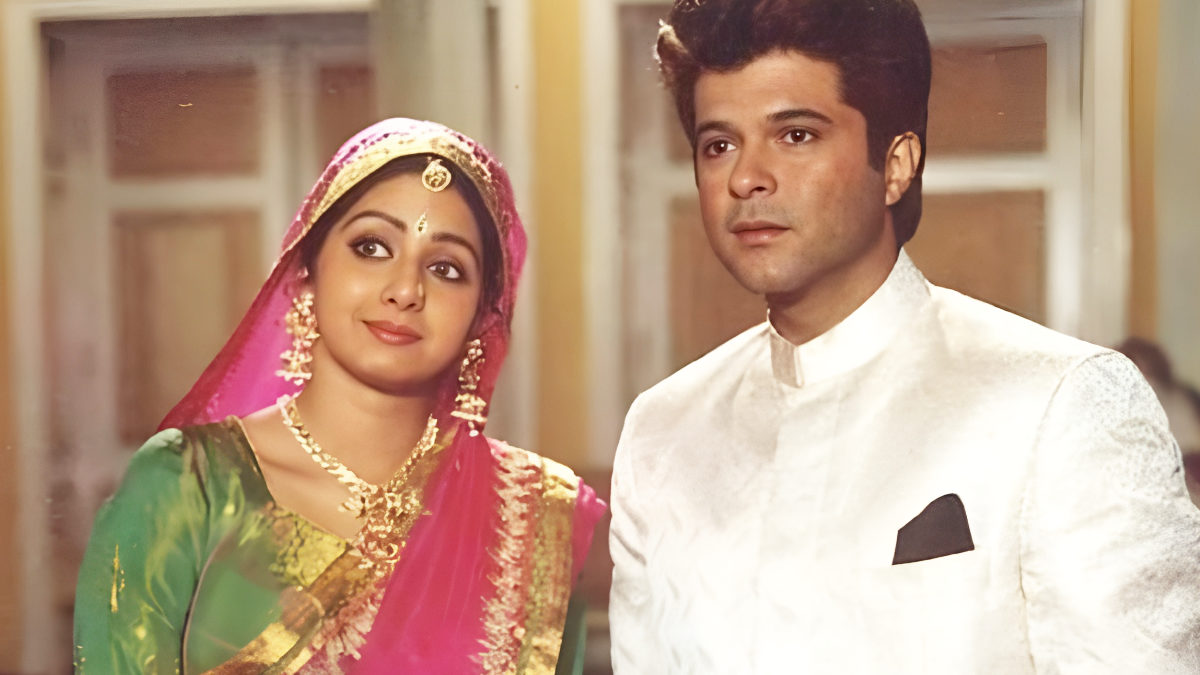In 1991, when mainstream Hindi cinema was soaked in vengeance dramas, family sagas, and love stories wrapped neatly in moral boundaries, Yash Chopra quietly dropped a film that didn’t fit anywhere – Lamhe. Lamhe was not loud or conventional, and most definitely it wasn’t comfortable. It dared to explore a kind of love that refused to be labelled — or accepted. At its heart, Lamhe was a story about time, memory, and emotional inheritance — but beneath that, it was a statement on how society defines morality and how the human heart refuses to obey it. In that single leap, Yash Chopra placed himself decades ahead of his time — and, perhaps, too far ahead for his audience to follow.
Most filmmakers of that era worked within the framework of idealised romance. Yash Chopra, however, chose to step into the shadows — to show love that’s imperfect, unsettling, and achingly human. Lamhe is about Viren (Anil Kapoor) falling for Pallavi (Sridevi), a woman older than him, embodying a love both pure and unfulfilled. Years later, he meets ‘her’ daughter, Pooja (also played by Sridevi), who mirrors her mother’s charm — and unknowingly rekindles that buried emotion.
It wasn’t an age-gap story. It was a psychological labyrinth — about a man haunted by the past, about desire disguised as devotion, and about love finding its way back through memory. Chopra had tapped into something deeply Freudian, but wrapped it in chiffon and melody — making the taboo look achingly poetic.
Visually, Lamhe was unlike anything Indian audiences had seen in the early ’90s. The sweeping landscapes of Rajasthan contrasted with the cool sophistication of London; the earthy, rooted emotions of Pallavi’s world collided with the free-spirited, Westernized Pooja.
Yash Chopra didn’t just shoot beauty — he designed emotional geography. Every frame carried intent. The transition from golden deserts to grey English skies symbolized time, loss, and rebirth. The costumes, composed in pastels and whites, stripped melodrama of its noise and gave romance a rare minimalism.
And then, there was Sridevi — playing both mother and daughter with such nuance that one could almost feel the generational echo. Her transformation wasn’t just physical; it was tonal. As Pallavi, she was grace and restraint; as Pooja, she was the embodiment of youthful rebellion. Yash Chopra, in his inimitable way, created a cinematic mirror — reflecting love through two faces of the same woman.
When Lamhe released, it met polite applause but commercial rejection. Audiences were uncomfortable — even disturbed — by what they saw as an “immoral” undertone. How could a man fall for the daughter of the woman he once loved! How could a filmmaker as romantic as Yash Chopra tread this forbidden emotional ground?
But that discomfort was precisely the point. Lamhe questioned our definition of love — whether it’s bound by age, relation, or social expectation. It asked if affection, in its purest form, can transcend the rules we create for it.
India, then in the early stages of liberalization, wasn’t ready for that question. The same audiences that celebrated Dilwale Dulhania Le Jayenge just four years later — a story about winning love over family disapproval — rejected Lamhe for defying it.
Yet, over time, the film found its believers. Critics revisited it. Audiences aged into it. Filmmakers cited it. What was once seen as scandalous became profound. And in that evolution lies the measure of -Yash Chopra’s foresight.
Today, Lamhe is regarded as one of Indian cinema’s most daring romantic dramas. It’s listed among Yash Chopra’s finest works — not because it succeeded, but because it dared. It redefined the language of Hindi film romance from melodrama to introspection.
Modern audiences, now accustomed to layered storytelling and emotionally complex characters, can finally see what Chopra attempted in 1991 — a meditation on unspoken longing, the passage of time, and the morality of emotion. In many ways, Lamhe predicted the cinematic maturity of a future Bollywood that hadn’t yet arrived.
Even in his later works — Veer-Zaara, Jab Tak Hai Jaan — one could sense Chopra’s continued fascination with love that defies simplicity. But it was Lamhe where he took his boldest leap. It was art without apology.
Three decades later, Lamhe stands vindicated. It wasn’t a failure — it was an experiment waiting for its audience to mature. It was a film about feelings we don’t speak of, attractions we don’t admit, and the time it takes for society to grow into understanding them.
Also Read: Get Ready for Bollywood in Britain! YRF to Shoot 3 Films in the UK, Boosting Economy
Yash Chopra didn’t just make a film about love; he made one about evolution — both emotional and cultural. And maybe that’s why Lamhe endures. It reminds us that some visions aren’t meant for the present — they’re designed for the future.
In 1991, India wasn’t ready for Lamhe. But Yash Chopra already was.

